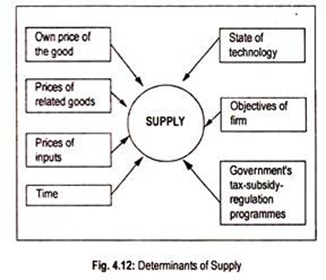After reading this article you will learn about: 1. Meaning of Supply 2. Determinants of Supply.
Meaning of Supply:
Supply is the quantity of a good which is offered for sale at a given price at a particular time. “The amount of a product that firms are able and willing to offer for sale is called the quantity supplied.”
Supply is a desired flow. It measures how much firms are willing to sell and not how much they actually sell. It is to be remembered that the firms may not supply the entire amount of a commodity that they produce per period of time. Supply may exceed or fall short of production. Supply in a particular year is the total production plus-minus stocks of the commodity.
Determinants of Supply:
Supply of a commodity depends not only on the price of that commodity but also on other factors.
ADVERTISEMENTS:
The supply function may now be expressed as:
Sx = f (Px, Pa… Pc, PL… PO, T, Cr, St, O, G),
Px → own price of good x,
Pa … Pc → prices of related goods,
ADVERTISEMENTS:
PL … PO→ prices of inputs,
T → time,
St → the state of technology,
O → objectives of the firm, and
ADVERTISEMENTS:
G → taxes, subsidies and regulation.
Now we will explain all these determinants of supply in brief:
(a) Own Price—Sx = f (Px):
Firstly, the most important factor that influences the supply of a commodity is its own price. And the relationship between supply and own price is a direct one.
(b) Prices of Related Goods—Sx = f (Pa … Pc):
Secondly, supply of any commodity largely depends not only on own price of the commodity but also on the prices of its substitute and complementary goods.
If market price of wheat rises, the jute farmers would be interested in wheat production so that in the next season they can increase the supply of wheat. On the other hand, in the case of a joint product, a rise in the market price of mutton will increase the quantity of leather supplied.
(c) Prices of Inputs—Sx = f (PL … Po):
Thirdly, price of inputs is also an important determinant of supply. If the price of an input (say, wage bill) rises, the cost of production will surely increase. Consequently, profit will tend to decline. Seeing an unprofitable situation, a firm will reduce the supply of a commodity and will try to switchover to the production of another commodity which is still not unprofitable.
ADVERTISEMENTS:
(d) Time—Sx = f (T):
Fourthly, in the short run, usually the supply of a commodity (mainly perishable good) is unresponsive to price change. But, in the long run, the supply of a commodity tends to be more flexible or fluctuating in response to the changing situation.
For non-reproducible goods, the supply becomes highly inelastic. One can now suggest that the supply of a commodity also depends on its nature. For instance, the supply of non-perishable goods responds more than the perishable goods when their prices change.
(e) Technology—Sx = f (St):
ADVERTISEMENTS:
Fifthly, the state of art or the technology has an important bearing on the supply of a commodity. As newer and modern technologies are employed in a concern, production and productivity rise and average costs of production tend to decline. This result in a change in quantity supplied.
(f) Firm’s Objectives—Sx = f (O):
Sixthly, the nature of a firm’s objectives also affects the supply decisions. Firms can have different goals. Usually, profit-maximization is the most fundamental objective of a firm. Modern business firms aim at maximization of sales revenue rather than profit.
Supply of a commodity under these two broad objectives is likely to be different. Thus, the supply of a commodity depends on the goals or objectives of a firm. Changes in these objectives of the firms will lead to a change in quantity supplied.
ADVERTISEMENTS:
(g) Government Policy—Sx = f (G):
Finally, by imposing taxes on firms, the government can affect the supply of a commodity. The government may ask business firms to pay taxes for polluting the atmosphere or for meeting government services on education, health, etc. As these taxes increase costs, firms reduce supplies. Similarly, subsidies may be given to firms so that they can produce goods needed by the society.
Often new firms are encouraged to produce some goods (e.g., software) by giving subsidies to these goods or by reducing taxes. Further, the government may use its regulatory device (e.g., industrial licensing) to control the activities of business firms. This affects supply.
All these determinants of supply have been represented in a diagrammatic form (Fig. 4.12):
